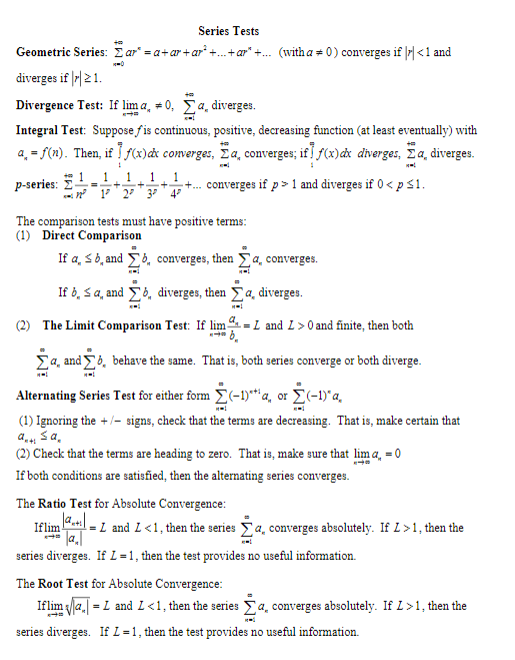Series Tests Geometric Series: Σ ar.-a+ ar + ar' +..tar" + (witha # 0) converges if I < 1 and vrges f 21 Divergence Test: If lima,#0, Σα.dverges. Integral Test: Suppose fis continuous, positive, decreasing function (at least eventually) with 4° f(n). Then, if If(x)ax converges, Σα. converges; if I f(x)ax dverges, Σα. diverges. p-series: Σ +-+-+-+.. converges if p > 1 and diverges if 0 < p 1 The comparison tests must have positive terms (1) Direct Comparison b. and Σ>, converges, then Σ a, converges. If a, If b, s a, and Σ4, diverges, then Σ a, diverges. (2) The Limit Comparison Test: If lim - 1 andan fin, then both Ya and b, behave the same. That is, both series converge or both diverge Alternating Series Test for either form Σ(-1)"'q or Σ(-1)"a, (1) Ignoring the + signs, check that the terms are decreasing. That is, make certain that (2) Check that the terms are heading to zero. That is, make sure that lima-o If both conditions are satisfied, then the alternating series converges. The Ratio Test for Absolute Convergence lflimPatil-L and L < 1 , then the series Σ a, converges absolutely. If L > 1 , then the series diverges. If L = 1 , then the test provides no useful information. The Root Test for Absolute Convergence !flim Vla,-L and L < 1 . then the series Σ a, converges absolutely. If L > 1 , then the series diverges. If L = 1 , then the test provides no useful information.
Series Tests Geometric Series: Σ ar.-a+ ar + ar' +..tar" + (witha # 0) converges if I < 1 and vrges f 21 Divergence Test: If lima,#0, Σα.dverges. Integral Test: Suppose fis continuous, positive, decreasing function (at least eventually) with 4° f(n). Then, if If(x)ax converges, Σα. converges; if I f(x)ax dverges, Σα. diverges. p-series: Σ +-+-+-+.. converges if p > 1 and diverges if 0 < p 1 The comparison tests must have positive terms (1) Direct Comparison b. and Σ>, converges, then Σ a, converges. If a, If b, s a, and Σ4, diverges, then Σ a, diverges. (2) The Limit Comparison Test: If lim - 1 andan fin, then both Ya and b, behave the same. That is, both series converge or both diverge Alternating Series Test for either form Σ(-1)"'q or Σ(-1)"a, (1) Ignoring the + signs, check that the terms are decreasing. That is, make certain that (2) Check that the terms are heading to zero. That is, make sure that lima-o If both conditions are satisfied, then the alternating series converges. The Ratio Test for Absolute Convergence lflimPatil-L and L < 1 , then the series Σ a, converges absolutely. If L > 1 , then the series diverges. If L = 1 , then the test provides no useful information. The Root Test for Absolute Convergence !flim Vla,-L and L < 1 . then the series Σ a, converges absolutely. If L > 1 , then the series diverges. If L = 1 , then the test provides no useful information.
Algebra & Trigonometry with Analytic Geometry
13th Edition
ISBN:9781133382119
Author:Swokowski
Publisher:Swokowski
Chapter10: Sequences, Series, And Probability
Section10.3: Geometric Sequences
Problem 50E
Related questions
Question
Hi,
Here's my question:
Determine if the series is absolutely convergent, conditionally convergent, or divergent.
(summation of n=1 and n goes to infinity of) sin(pi(n)/6)/(1+n^(3/2))
This series converges by the Direct Comparison Test (see photo of a list of series tests below), but I need to use another test or two to find if the series is conditionally or absolutely convergent. However, I don't know which one in the list to use. All I know is that I can't use the root test, and it doesn't seem like the
Thanks!

Transcribed Image Text:Series Tests
Geometric Series: Σ ar.-a+ ar + ar' +..tar" + (witha # 0) converges if I < 1 and
vrges f 21
Divergence Test: If lima,#0, Σα.dverges.
Integral Test: Suppose fis continuous, positive, decreasing function (at least eventually) with
4° f(n). Then, if If(x)ax converges, Σα. converges; if I f(x)ax dverges, Σα. diverges.
p-series: Σ +-+-+-+.. converges if p > 1 and diverges if 0 < p 1
The comparison tests must have positive terms
(1) Direct Comparison
b. and Σ>, converges, then Σ a, converges.
If a,
If b, s a, and Σ4, diverges, then Σ a, diverges.
(2) The Limit Comparison Test: If lim
- 1 andan fin, then both
Ya and
b, behave the same. That is, both series converge or both diverge
Alternating Series Test for either form Σ(-1)"'q or Σ(-1)"a,
(1) Ignoring the + signs, check that the terms are decreasing. That is, make certain that
(2) Check that the terms are heading to zero. That is, make sure that lima-o
If both conditions are satisfied, then the alternating series converges.
The Ratio Test for Absolute Convergence
lflimPatil-L and L < 1 , then the series Σ a, converges absolutely. If L > 1 , then the
series diverges. If L = 1 , then the test provides no useful information.
The Root Test for Absolute Convergence
!flim Vla,-L and L < 1 . then the series Σ a, converges absolutely. If L > 1 , then the
series diverges. If L = 1 , then the test provides no useful information.
Expert Solution
This question has been solved!
Explore an expertly crafted, step-by-step solution for a thorough understanding of key concepts.
This is a popular solution!
Trending now
This is a popular solution!
Step by step
Solved in 3 steps with 2 images

Knowledge Booster
Learn more about
Need a deep-dive on the concept behind this application? Look no further. Learn more about this topic, calculus and related others by exploring similar questions and additional content below.Recommended textbooks for you

Algebra & Trigonometry with Analytic Geometry
Algebra
ISBN:
9781133382119
Author:
Swokowski
Publisher:
Cengage

Algebra & Trigonometry with Analytic Geometry
Algebra
ISBN:
9781133382119
Author:
Swokowski
Publisher:
Cengage